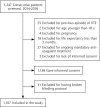General Practitioner-Performed Compression Ultrasonography for Diagnosis of Deep Vein Thrombosis of the Leg: A Multicenter, Prospective Cohort Study
- PMID: 29133492
- PMCID: PMC5683865
- DOI: 10.1370/afm.2109
General Practitioner-Performed Compression Ultrasonography for Diagnosis of Deep Vein Thrombosis of the Leg: A Multicenter, Prospective Cohort Study
Abstract
Background: Patients with suspected deep vein thrombosis (DVT) of the lower limb represent a diagnostic dilemma for general practitioners. Compression ultrasonography (US) is universally recognized as the best test of choice. We assessed the diagnostic accuracy of compression US performed by general practitioners given short training in the management of symptomatic proximal DVT.
Methods: From May 2014 to May 2016, we evaluated in a multicenter, prospective cohort study all consecutive outpatients with suspected DVT; bilateral proximal lower limb compression US was performed by general practitioners and by physicians expert in vascular US, each group blinded to the other's findings. In all examinations with a negative or nondiagnostic result, compression US was repeated by the same operator after 5 to 7 days. Inter-observer agreement and accuracy were calculated.
Results: We enrolled a total of 1,107 patients. The expert physicians diagnosed DVT in 200 patients, corresponding to an overall prevalence of 18.1% (95% CI, 15.8%-20.3%). The agreement between the trained general practitioners and the experts was excellent (Cohen κ = 0.86; 95% CI, 0.84-0.88). Compression US performed by general practitioners had a sensitivity of 90.0% (95% CI, 88.2%-91.8%) and a specificity of 97.1% (95% CI, 96.2%-98.1%) with a diagnostic accuracy for DVT of 95.8% (95% CI, 94.7%-97.0%).
Conclusions: Our results suggest that, even in hands of physicians not expert in vascular US, compression US can be a reliable tool in the diagnosis of DVT. We found that the sensitivity achieved by general practitioners appeared suboptimal, however, so future studies should evaluate the implementation of proper training strategies to maximize skill.
Keywords: accuracy; compression ultrasound; deep vein thrombosis; diagnosis; general practitioner; practice-based research; primary care.
© 2017 Annals of Family Medicine, Inc.
Conflict of interest statement
Conflicts of interest: authors report none.
Figures
Similar articles
-
Accuracy of nurse-performed compression ultrasonography in the diagnosis of proximal symptomatic deep vein thrombosis: a prospective cohort study.J Thromb Haemost. 2014 Apr;12(4):430-5. doi: 10.1111/jth.12522. J Thromb Haemost. 2014. PMID: 24495051
-
Analysis of an algorithm incorporating limited and whole-leg assessment of the deep venous system in symptomatic outpatients with suspected deep-vein thrombosis (PALLADIO): a prospective, multicentre, cohort study.Lancet Haematol. 2015 Nov;2(11):e474-80. doi: 10.1016/S2352-3026(15)00190-8. Epub 2015 Oct 18. Lancet Haematol. 2015. PMID: 26686257 Clinical Trial.
-
Emergency Department compression ultrasound to diagnose proximal deep vein thrombosis.J Emerg Med. 2001 Feb;20(2):107-12. doi: 10.1016/s0736-4679(00)00302-4. J Emerg Med. 2001. PMID: 11207402
-
The rate of missed diagnosis of lower-limb DVT by ultrasound amounts to 50% or so in patients without symptoms of DVT: A meta-analysis.Medicine (Baltimore). 2019 Sep;98(37):e17103. doi: 10.1097/MD.0000000000017103. Medicine (Baltimore). 2019. PMID: 31517841 Free PMC article.
-
Exclusion and diagnosis of deep vein thrombosis in outpatients by sequential noninvasive tools.Int Angiol. 2002 Mar;21(1):9-19. Int Angiol. 2002. PMID: 11941269 Review.
Cited by
-
Direct-access to sonographic diagnosis of deep vein thrombosis in general practice: a descriptive cohort study.BMC Fam Pract. 2020 Sep 21;21(1):195. doi: 10.1186/s12875-020-01267-x. BMC Fam Pract. 2020. PMID: 32957932 Free PMC article.
-
Point-of-Care Ultrasound in General Practice: A Systematic Review.Ann Fam Med. 2019 Jan;17(1):61-69. doi: 10.1370/afm.2330. Ann Fam Med. 2019. PMID: 30670398 Free PMC article.
-
The utility of point of care ultrasonography (POCUS).Ann Med Surg (Lond). 2021 Nov 2;71:102982. doi: 10.1016/j.amsu.2021.102982. eCollection 2021 Nov. Ann Med Surg (Lond). 2021. PMID: 34840746 Free PMC article. No abstract available.
-
Point-of-care ultrasound in primary care: a systematic review of generalist performed point-of-care ultrasound in unselected populations.Ultrasound J. 2019 Nov 19;11(1):31. doi: 10.1186/s13089-019-0145-4. Ultrasound J. 2019. PMID: 31749019 Free PMC article. Review.
-
The Use of Point-of-Care Ultrasound (POCUS) in the Diagnosis of Deep Vein Thrombosis.J Clin Med. 2021 Aug 30;10(17):3903. doi: 10.3390/jcm10173903. J Clin Med. 2021. PMID: 34501350 Free PMC article. Review.
References
-
- Qaseem A, Snow V, Barry P, et al. Joint American Academy of Family Physicians/American College of Physicians Panel on Deep Venous Thrombosis/Pulmonary Embolism. Current diagnosis of venous thromboembolism in primary care: a clinical practice guideline from the American Academy of Family Physicians and the American College of Physicians. Ann Intern Med. 2007;146(6):454–458. - PubMed
-
- Kearon C. Natural history of venous thromboembolism. Circulation. 2003;107(23)(Suppl 1):I22–I30. - PubMed
-
- Oudega R, Hoes AW, Moons KGM. The Wells rule does not adequately rule out deep venous thrombosis in primary care patients. Ann Intern Med. 2005;143(2):100–107. - PubMed
-
- Büller HR, Ten Cate-Hoek AJ, Hoes AW, et al. AMUSE (Amsterdam Maastricht Utrecht Study on thromboEmbolism) Investigators. Safely ruling out deep venous thrombosis in primary care. Ann Intern Med. 2009;150(4):229–235. - PubMed
Publication types
MeSH terms
LinkOut - more resources
Full Text Sources
Other Literature Sources
Medical

